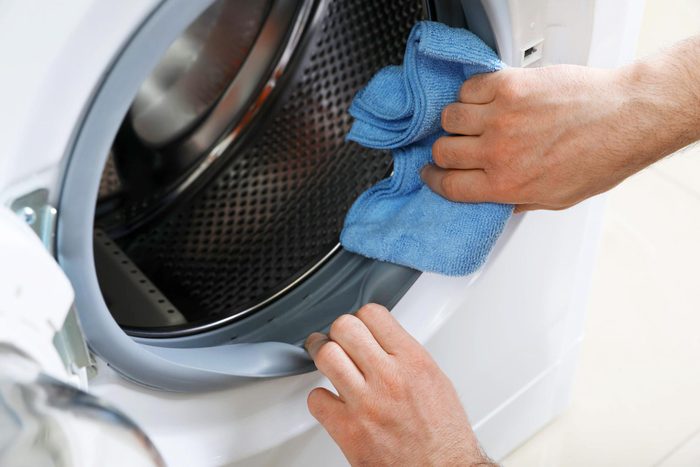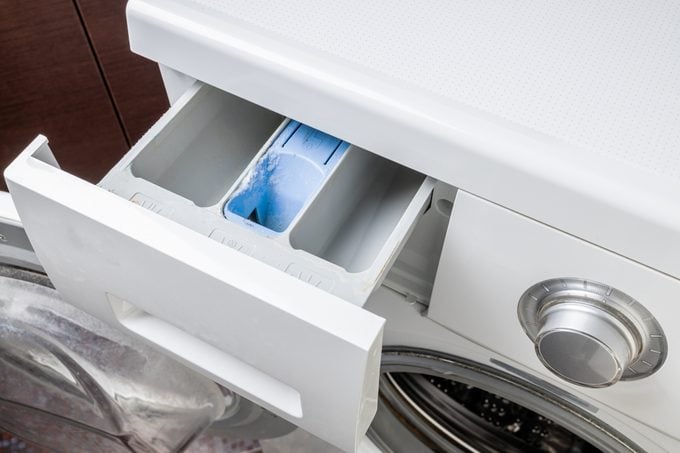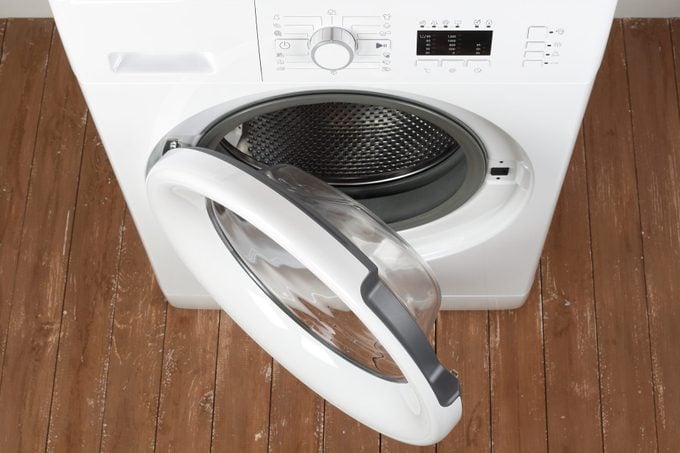How to Clean a Smelly Washing Machine
Updated: Feb. 09, 2024

Here's how to clean a washing machine and eliminate odor-causing mildew, soap scum and bacteria.
Everyone loves the smell of laundry fresh out of the washer and dryer. It’s so clean and crisp—until your washing machine starts to stink! That foul odor is caused by a buildup of bacteria, mildew and soap scum. Here’s how to clean a washing machine and restore that fresh smell.
How to Clean Inside a Washing Machine
Perform this basic cleaning routine on your washing machine once a month or every 30 washes.
Tools
- Microfiber cloth
- Washing machine cleaning tablet
- Bleach or vinegar
- Soft toothbrush
Directions
Step 1: Clean the filter
Your washer’s filter could collect buildup that’s causing the smell.
Most top-loading machines do not have an accessible filter (unless you have a Samsung which has three potential filter locations).
In front loading models, the drain pump filter is usually located at the base of the washer, on the front right side. Refer to your owner’s manual to access the filter. Place a shallow dish and towels under the pump access door because you’ll probably catch about a cup of water when the filter is removed. Clean the filter under running water with a soft brush, then put it back in place.
Step 2: Clean the detergent dispenser

If you notice detergent or fabric softener residue in the detergent drawer, it’s time to give it a good clean. Pull out the drawer until it stops, then lift up the front to remove it completely from the washing machine. Wash the drawer in warm, soapy water using mild soap. (Do not put it in the dishwasher.) Rinse away any soap, dry with a soft towel and re-insert the drawer.
Step 3: Wipe down the door and seal
Using a damp cloth, clean the gasket (the rubber seal surrounding the washer opening) and interior door window. When cleaning the gasket, make sure to press down on the rubber lip and thoroughly clean inside. You can also use vinegar and a soft toothbrush to scrub away stubborn stains and odors in the gasket.
Step 4: Run a cleaning cycle
Cleaning the drum of the washer is as easy as pushing a button. Remove any clothes from the washer, then add a washing machine cleaner tablet or pour in one cup of bleach or vinegar to the bottom of the drum. Whirlpool recommends this Affresh tablet.
Close the lid and select the “self clean cycle” if your washer has one, or run a normal hot water cycle.
Keep in mind, newer washers (like certain Samsung models) have self-clean cycles that do not require any detergent or bleach. It never hurts to check the manufacturer’s instructions.
How to Remove Mold and Mildew
According to GE Appliances, vinegar and extra hot water work best when cleaning mold and mildew from your washer. Pour two cups of white vinegar into your empty washing machine tub and select the hottest and longest available cycle. When the wash cycle is finished, leave the door open and allow the tub to fully dry.
How to Descale a Washing Machine
If your home has hard water, you might notice calcium deposits in your washer that look like white residue. Once again, vinegar is the answer. (Honestly, vinegar cleans almost anything!)
Pour four cups of white vinegar into your empty washing machine tub and select the hottest and longest cycle. When it’s done, wipe down the drum interior with a damp sponge. Then run another wash cycle with no detergent to rinse away any remaining vinegar.
How to Keep Your Washing Machine Clean

Leave the door open after each wash
Mold and mildew love moist environments. If you close the door after a wash cycle, it doesn’t allow the interior to thoroughly dry. Leave the door ajar so air flow can completely dry the drum and gasket.
Don’t use too much detergent
You might think a stinky washer means you’re not using enough detergent, but the opposite is true. Avoid one of the most common laundry mistakes by carefully following the detergent measurement guide based on load size and soil level. Using too much detergent will cause buildup that will lead to bad smells and leave residue on the clothing. Be sure to use HE detergent, and Whirlpool recommends avoiding powdered detergent, which doesn’t always dissolve well.
Regularly clean the filter
Cleaning the filter on your washing machine is easy to forget because it’s not as visible, but regularly cleaning it will fight odors and keep your washer running at top performance. Most manufacturers recommend cleaning the filter about every three months.
Don’t wait for musky odors to arise to clean your washing machine. Instead, add this process to your regular cleaning schedule along with your other monthly tasks. We recommend adding a reminder in your phone or a note on your calendar to stay on top of it—and say goodbye to stinky laundry smells.
